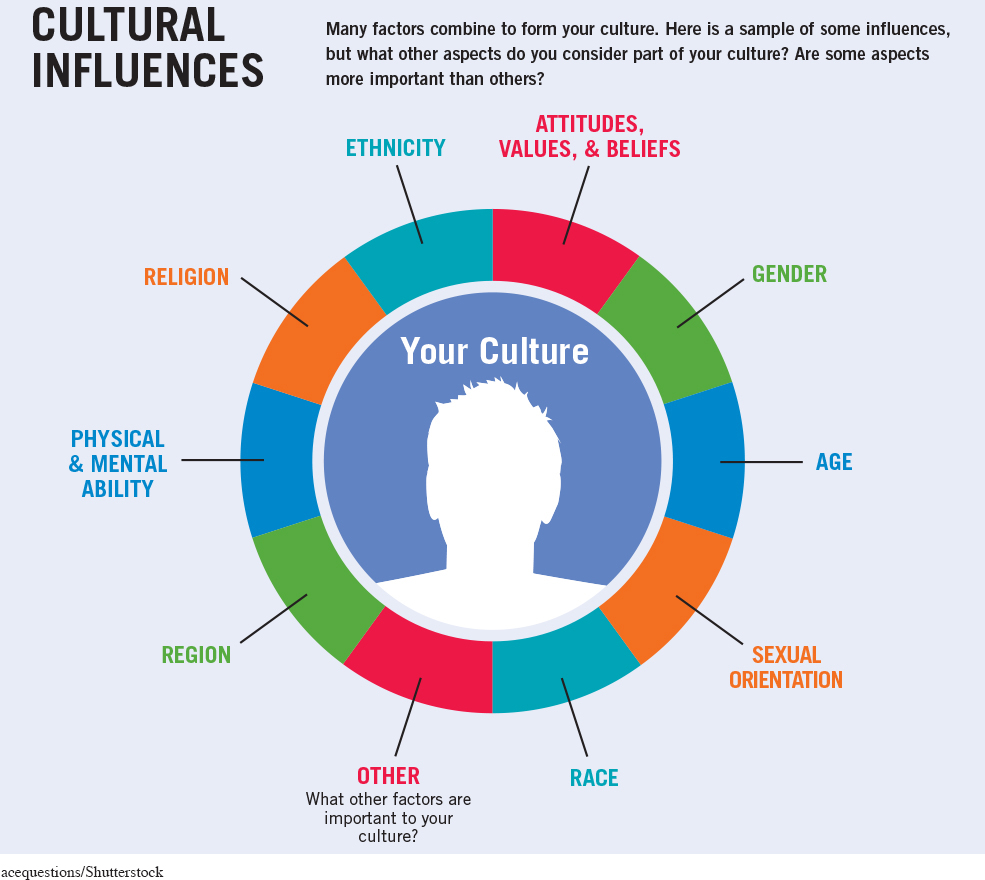Culture Defined
In this book, we take a broad and inclusive view of culture, defining it as an established, coherent set of beliefs, attitudes, values, and practices shared by a large group of people (Keesing, 1974). Culture includes many types of influences, such as your nationality, ethnicity, religion, gender, sexual orientation, physical abilities, and age. But what really makes a culture a “culture” is that it’s widely shared. This happens because cultures are learned, communicated, layered, and lived.
WHAT IS YOUR CULTURE?
Culture is so integrated into your everyday life that it is easy to overlook how it can inform everything you see, hear, or believe. How do the activities and images shown relate to your culture or not? What other aspects of your culture make you you?

Culture Is Learned. You learn your cultural beliefs, attitudes, and values from many sources, including your parents, teachers, religious leaders, peers, and the mass media (Gudykunst & Kim, 2003). This process begins at birth, through customs such as choosing a newborn’s name, taking part in religious ceremonies, and selecting godparents or other special guardians. As you mature, you learn deeper aspects of your culture, including the history behind certain traditions—
Culture Is Communicated. Each culture has its own practices regarding how to communicate (Whorf, 1952). Imagine you’re part of a group project and the other members decide to do the assignment in a particular way. If you grew up in Singapore, where your culture would emphasize group harmony over personal preferences, you’d be expected to support the group’s decision, even if you thought another approach would be better. Withholding your dissenting opinion would be considered competent communication. American culture, however, stresses the importance of individual expression. So if you grew up in the United States, you’d probably feel that it’s perfectly acceptable—
Culture Is Layered. Many people belong to more than one culture simultaneously. This means they experience multiple layers of culture, as various traditions, heritages, and practices are recognized and held to be important. Steve’s Uncle Rick, for example, is originally from Canada but is now an American citizen. Rick is passionate about being an American: he played hockey for a U.S. collegiate team, is deeply patriotic, sings the national anthem at ball games, and celebrates the Fourth of July. But every four years, when the Winter Olympics roll around, his Canadian cultural allegiance emerges from beneath the American layer, and he cheers on the Canadians over and above everyone else—
Culture Is Lived. Culture affects everything about how you live your life. It influences the neighborhoods you live in; the means of transportation you use; the way you think, dress, talk, and even eat. Its impact runs so deep that it is often taken for granted. At the same time, culture is often a great source of personal pride. Many people consciously live in ways that celebrate their cultural heritage—
